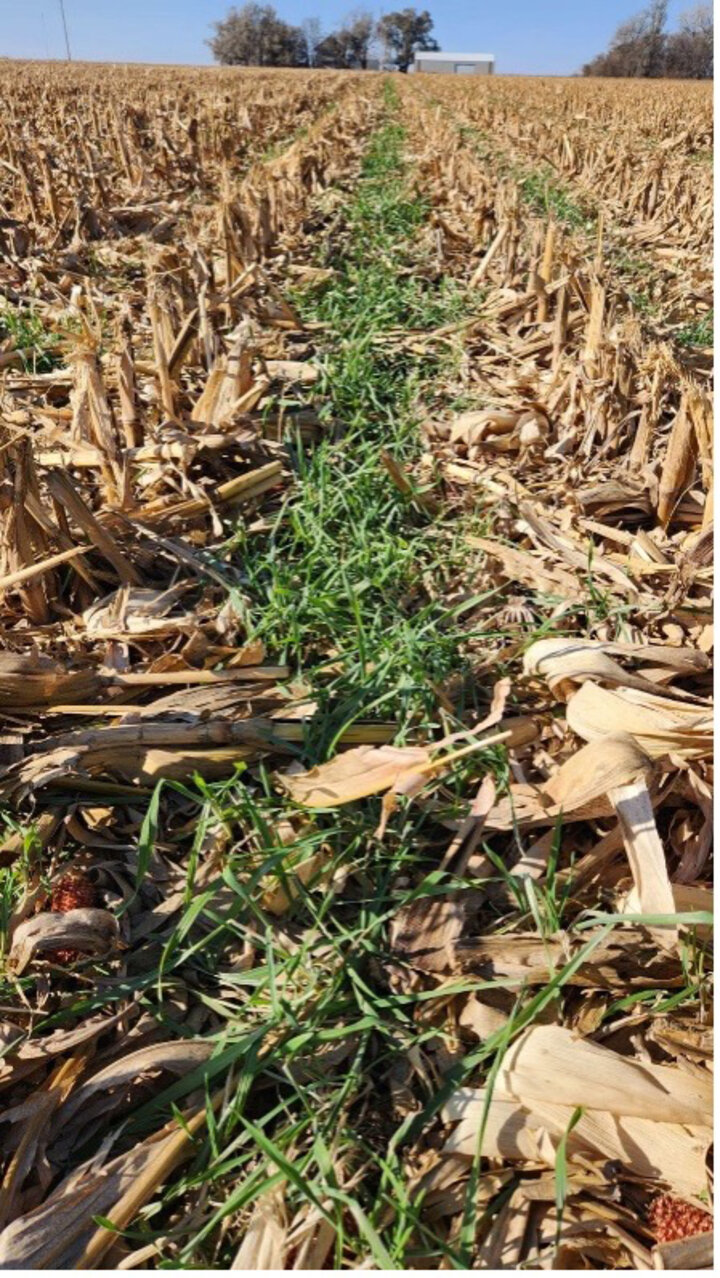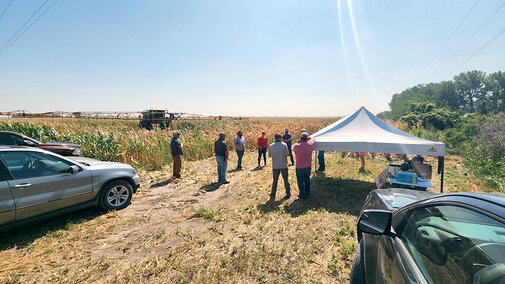Introduction
Cover crops are a recognized method for increasing soil health by reducing soil erosion, increasing soil organic matter and improving soil structure. Cover crops can also safeguard water quality by reducing nitrate leaching.
While cover crops are growing in popularity in Nebraska, there are many challenges that limit widespread adoption. One example is the narrow window for cover crop establishment from harvest to first (hard) frost. To address these challenges, the Highboy Cover Crop Interseeding Project (HiCCIP) was initiated by the University of Nebraska-Lincoln in 2022. This collaborative effort with the Nebraska Department of Environment and Energy (NDEE) and various Natural Resources Districts (NRDs), including the Lower Platte North NRD, Lower Platte South NRD, and the Upper Big Blue NRD, aims to address cover crop barriers and explore their impact on water quality. Information about what we learned in year one can be viewed in this article.
Synopsis of Fall 2022 Interseeding Accomplishments
In 2022, a highboy interseeder (Figure 1) was utilized to interseed cover crops across 2,972 acres in 33 corn fields throughout Nebraska. Each field received a broadcast application of either cereal rye or a mix of cover crops, including cereal rye, turnips and rapeseed, at an average rate of 70 lb/ac.
Most of the fields were interseeded in August, with select fields being interseeded in early September as corn was observed between the R4 and R6 growth stage. Growers were asked to apply at least one application of 0.5-inch irrigation immediately following field site interseeding to facilitate cover crop germination.
Our team collected cover crop stand counts at 19 fields in October 2022. For fields with cereal rye only, stand counts ranged from 20% to 60% of the applied rate of 34 seeds/sq ft (70 lb/ac equivalent). In contrast, fields (n=19) broadcasted with a mix observed an average stand count of 52%.

Fall 2023 Interseeding — Changing the Approach
As we moved into spring 2023, our team noted poor cover crop growth performance for many field sites interseeded during fall 2022. Poor performance was likely attributed to the combined effect of a dry 2022 growing season, following a dry fall and winter. No biomass data was collected during spring 2023.
For more info on the highboy interseeding cover crop project,
click here
In 2023, building upon the insights gained from the previous year's demonstrations, we collaborated with 24 growers to interseed cover crops across 26 fields, covering approximately 3,400 acres, with a base rate of 70 lb/ac. We implemented several modifications to enhance the effectiveness of the HiCCIP demonstrations.
First, we adjusted the interseeding dates based on observations that the early timing of interseeding (fall 2022), when corn was still green and sunlight was mostly intercepted by the canopy, hindered cover crop growth post-germination. In 2023, we started interseeding on Aug. 28, when corn was at R5.5 growth stage. At this stage, corn plants are approaching maturity, and drying leaves allowed more sunlight to reach the soil surface, allowing for better cover crop growth compared to the earlier interseeding dates in 2022.
For the 2023 growing season, on-farm research trials were conducted. Figure 2 shows an example of the experimental layout we used for OFR trials. Experimental layout included replicated check strips with no cover crops, alongside various treatment combinations:
- Interseeded × check (no cover crops).
- Interseeded × drilled.
- Interseeded × drone interseeded.
- 2x interseeded rate.
Studies were also conducted in two hailed fields. Observations on cover crop stand count, cover crop biomass and soil nitrate content at 0-1, 1-2, and 2-3 feet will be collected across the treatments in each field. Grain yield data to evaluate yield impact will be collected during the fall of 2024.

Fall 2023 Interseeding Preliminary Results
Figure 3 shows preliminary stand counts for 13 fields interseeded during fall 2023. Stand count is presented as a percent (%) of plants emerged, which is the total emerged plants relative to the total number of seed planted. For example, the expected number of cereal rye plants is 34 per square foot at 70 lb/ac, and the counted emerged living plants was 17 plants per square foot, therefore emergence rate is 50% (17÷34). Values ranged from 1% to 84% with an average of 27% emergence rate for the fields interseeded with cereal rye. The emergence rate for the fields interseeded with the cover crop mix ranged from 16% to 77% with an average of 41%.

Although the cover crop emergence rate observed during fall 2023 was similar to those found during fall 2022, the later interseeding date and stand count assessments in 2023 resulted in a stand count that was not negatively affected as observed in 2022. To demonstrate that, Figure 4 shows a picture taken on Nov. 11, 2023, about 10 days after corn harvest. We observed that the cover crops were well established. During late fall 2022, however, little to no cover crop establishment was found (visual assessment).
Moving forward into spring 2024, our team is going to assess cover crop biomass and stand count at the same locations as fall 2023. Additionally, we plan to conduct soil sampling to evaluate any changes in soil nitrogen levels during the cover crop season.
Acknowledgements
We would like to thank our collaborating farmers, the Lower Platte North, the Lower Platte South, and Upper Big Blue NRDs for providing their fields and/or technical support for this project.
Funding
Funding provided by the Nebraska Department of Environmental and Energy Nonpoint Source Pollution Program and USDA-NIFA.


